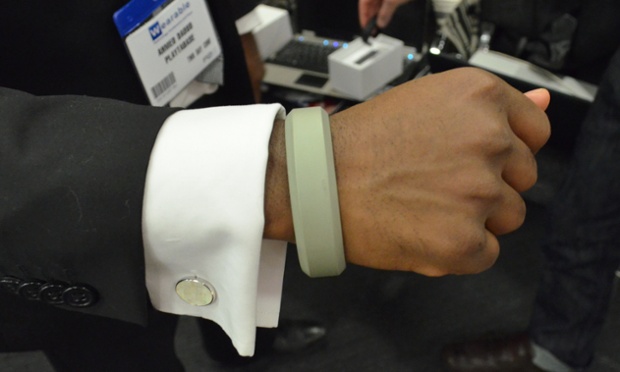
The Reemo gesture band is aims to turn the real world into a point and click environment. It does not require the dexterity of a smartphone tap or a mouse click, but instead recognises simple pointing and waving gestures, with receivers hooked up to appliances around the home.
The developers, Playtabase, expect the band itself to cost around $125 with receivers costing around $30 in May this year. While home automation, fitness and gaming are obvious applications, Playtabase also suggested that the Reemo could be used by the elderly or those with limited muscle control for simplified interactions with computers and other controllable objects. Photograph: Samuel Gibbs/The Guardian
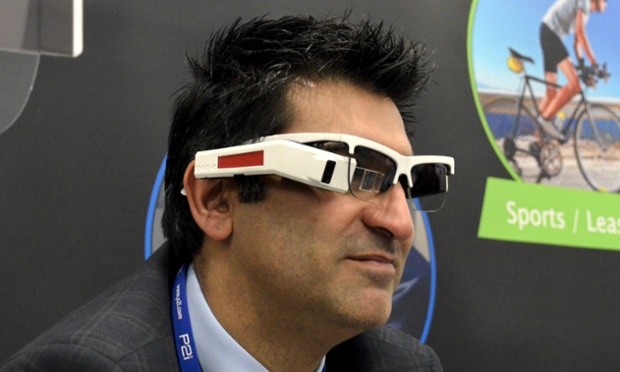
An alternative to Google Glass and Vuzix smart glasses, the Optinvent Ora augmented reality glasses put a see-through screen in your vision.
Effectively built on an Android smartphone with data but without phone connectivity, the Ora smartglasses have a screen three-times larger than Google Glass, overlaying information on your vision as you go about your day.
The screen can be mounted directly in your line of sight or flipped down to just below for at-a-glance information. Optinvent is looking for developers and enterprise partners to pick up the smartglasses, which cost €700, to create at least 40 apps before launching for consumers in 2015. Photograph: Samuel Gibbs/The Guardian
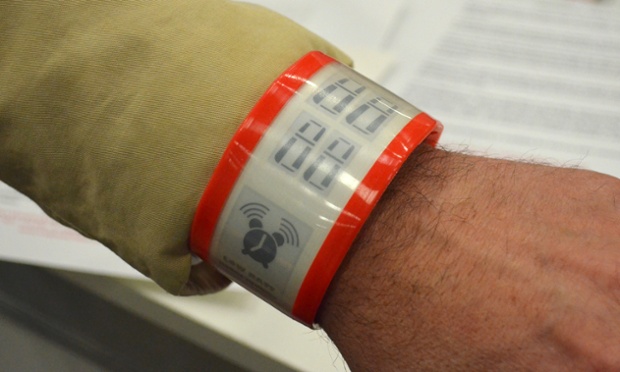
The SnapWatch concept, first theorised in 1999 and patented in 2005, pairs a flexible display to a snap band reminiscent of the Slap Bracelets of the 1980s and 1990s.
When struck against the wrist the band coils around, forming a fitted bracelet. Photograph: Samuel Gibbs/The Guardian
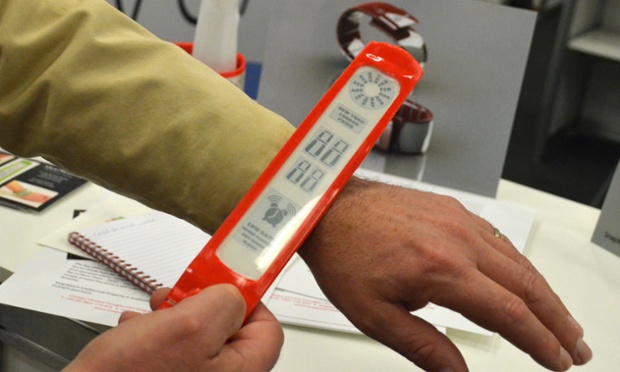
The concept, which currently uses an electrochromic display, has been built into prototypes of music players, watches and smartwatches. The inventor, Vincent Douglas, admits that some miniaturisation is required on the control circuitry part, but is actively looking for partners to make the SnapWatch a reality beyond simple prototypes, now that display technology like flexible E-ink has come to fruition. Photograph: Samuel Gibbs/The Guardian
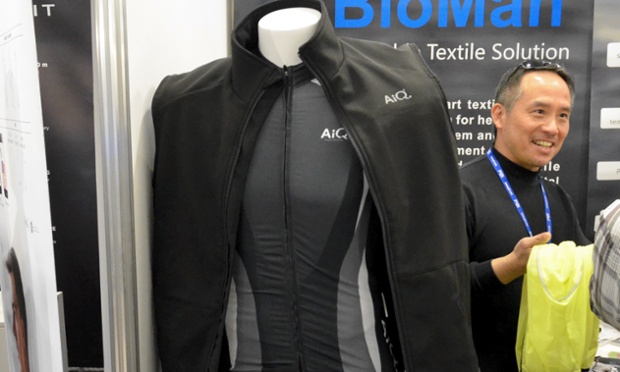
AiQ is a smart clothing manufacturer, which has created super-thin stainless steel fibres that feel like wool. These fibres are weaved through the fabric enabling a whole range of smart features.
A top is currently available that has the wiring running across the chest can be used with a heart rate monitor to measure a person’s heart rate during training, but AiQ are working with universities in Taiwan on much more than that.
A concept design that can measure a wearers EEG, ECG, stress levels, fat content, muscle strength or anything else that uses current applied through the skin is expected to be in prototype form within six months, powered by a clip-on Bluetooth module. Photograph: Samuel Gibbs/The Guardian
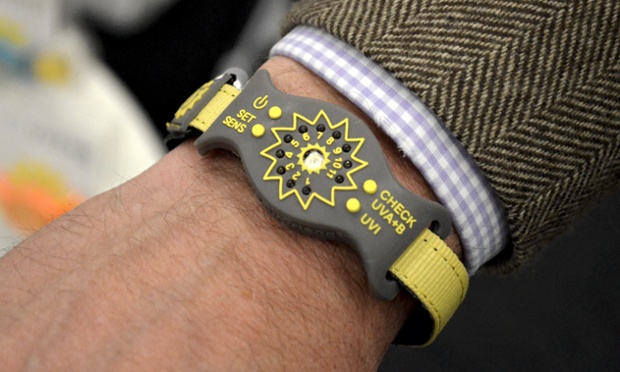
The SunFriend is a watch-like device that uses sensors to measure your UVA and UVB exposure from the Sun. Users can alter their skin sensitivity rating creating a personalised dosage meter, getting a warning when they have hit their limit.
It was developed over three years off the back of some Nasa technology around UV monitoring. The SunFriend is waterproof to 3m and will be available for around £40 in the next month. A more advanced version, which links to a smartphone via Bluetooth for displaying information, is currently under development and is expected in the first quarter of 2015. Photograph: Samuel Gibbs/The Guardian
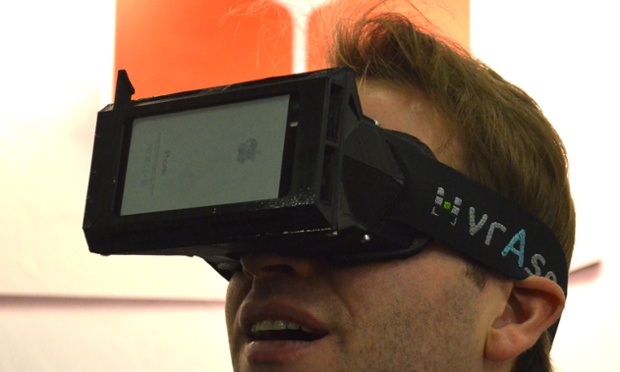
Vrase is essentially an Oculus Rift that uses a smartphone for the display. The accessory headset straps to the face with a slot for a smartphone – the iPhone and a variety of Android phones are currently supported.
The smartphone is then used to display a split screen image, which the Vrase headset turns into a 3D picture. Photograph: Samuel Gibbs/The Guardian
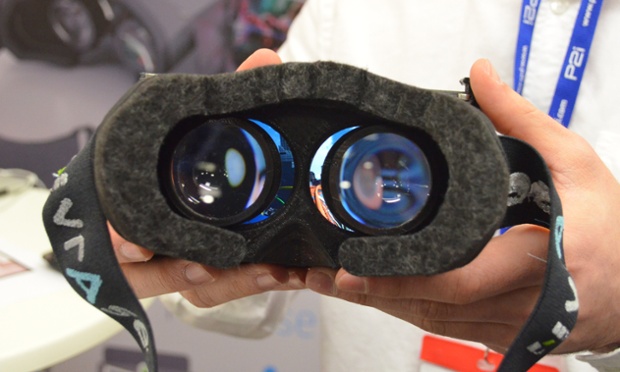
As the developers of Vrase state, one advantage the accessory has over most other virtual reality headset designs is the rapid technological evolution of the smartphone. It can utilise the increasing power of smartphones, as well as their equipment including the motion sensors and cameras to create more immersive and constantly up to date experiences, as well as benefitting from the Android and Apple app stores. Photograph: Samuel Gibbs/The Guardian
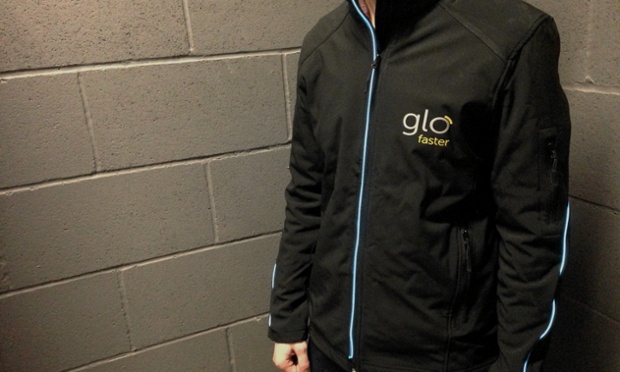
Developed over the last two years by ex-Royal Marine Simon Weatherall, Glofaster is a light-up jacket that pairs with sensors to detect your heart rate and give the wearer instant visual feedback on while training.
The original idea appeared on the BBC’s Dragon’s Den, starting out with some wires, lights, velcro and some brave volunteers. The jacket, design by former Abercrombie and Fitch designer Joanna Kent, is now washable, has integrated light strips and is powered by a removable battery pack for £99.
The electronic component of the system called The Gizmo, which connects to sensors and a smartphone app, is still under development and is expected to be ready for manufacturing in the next six months. Photograph: Alex Hern/The Guardian
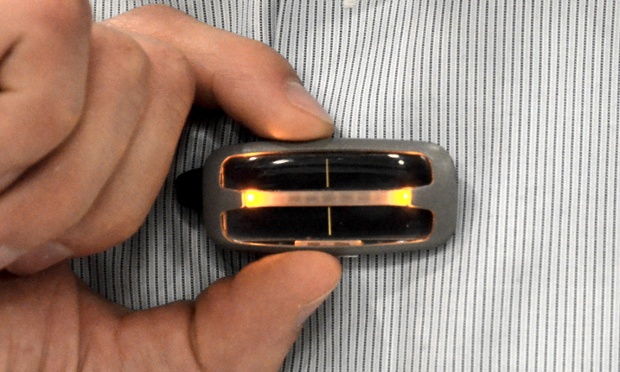
The product of two PhD graduates from Harvard, the SunSprite is a UV and light exposure meter that uses special filters to match the level of bright light entering your eye.
The little sensor is solar powered, connecting to a smartphone via Bluetooth, but also displaying your light dosage at a glance on a strip of LEDs.
While it can be used to measure UV exposure, the SunSprite is designed to measure bright light exposure for treating and monitoring seasonal affective disorder (Sad) – a condition that can cause depression and other negative effects when a person does not get enough bright light exposure via the eyes, often more prevalent in winter. Photograph: Samuel Gibbs/The Guardian
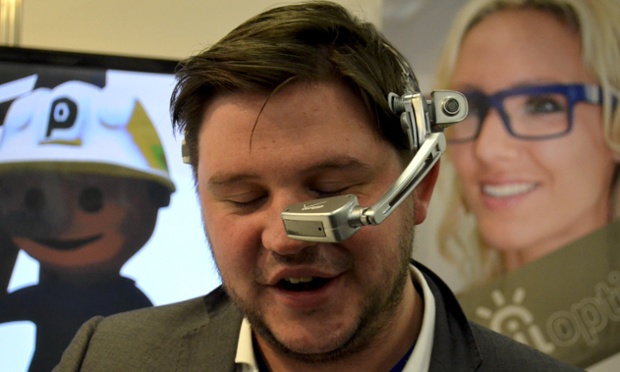
Looking like something out of a science fiction war film, the Kopin Golden-i 3.8D is an advanced ruggedised wearable computer, built around an Android smartphone without the cellular connectivity, just like the Optinvent Ora.
It has a 14-megapixel camera complete with zoom, responds to voice commands and runs Android 4.2 complete with a custom interface and Skype, allowing headset to headset communication.
Kopin, however, is aiming this at anyone who needs hands-free access to information while on the job. It is the fifth generation of the system costing $1,500, and is being used as a reference design for manufacturers targeting enterprise. Photograph: Samuel Gibbs/The Guardian
INTERNATIONAL CONCEPT OF WORK FROM HOME
ReplyDeleteWork from home theory is fast gaining popularity because of the freedom and flexibility that comes with it. Since one is not bound by fixed working hours, they can schedule their work at the time when they feel most productive and convenient to them. Women & Men benefit a lot from this concept of work since they can balance their home and work perfectly. People mostly find that in this situation, their productivity is higher and stress levels lower. Those who like isolation and a tranquil work environment also tend to prefer this way of working. Today, with the kind of communication networks available, millions of people worldwide are considering this option.
Women & Men who want to be independent but cannot afford to leave their responsibilities at home aside will benefit a lot from this concept of work. It makes it easier to maintain a healthy balance between home and work. The family doesn't get neglected and you can get your work done too. You can thus effectively juggle home responsibilities with your career. Working from home is definitely a viable option but it also needs a lot of hard work and discipline. You have to make a time schedule for yourself and stick to it. There will be a time frame of course for any job you take up and you have to fulfill that project within that time frame.
There are many things that can be done working from home. A few of them is listed below that will give you a general idea about the benefits of this concept.
Baby-sitting
This is the most common and highly preferred job that Women & Men like doing. Since in today's competitive world both the parents have to work they need a secure place to leave behind their children who will take care of them and parents can also relax without being worried all the time. In this job you don't require any degree or qualifications. You only have to know how to take care of children. Parents are happy to pay handsome salary and you can also earn a lot without putting too much of an effort.
Nursery
For those who have a garden or an open space at your disposal and are also interested in gardening can go for this method of earning money. If given proper time and efforts nursery business can flourish very well and you will earn handsomely. But just as all jobs establishing it will be a bit difficult but the end results are outstanding.
Freelance
Freelance can be in different wings. Either you can be a freelance reporter or a freelance photographer. You can also do designing or be in the advertising field doing project on your own. Being independent and working independently will depend on your field of work and the availability of its worth in the market. If you like doing jewellery designing you can do that at home totally independently. You can also work on freelancing as a marketing executive working from home. Wanna know more, email us on workfromhome.otr@gmail.com and we will send you information on how you can actually work as a marketing freelancer.
Internet related work
This is a very vast field and here sky is the limit. All you need is a computer and Internet facility. Whatever field you are into work at home is perfect match in the software field. You can match your time according to your convenience and complete whatever projects you get. To learn more about how to work from home, contact us today on workfromhome.otr214424@gmail.comand our team will get you started on some excellent work from home projects.
Diet food
Since now a days Women & Men are more conscious of the food that they eat hence they prefer to have homemade low cal food and if you can start supplying low cal food to various offices then it will be a very good source of income and not too much of efforts. You can hire a few ladies who will help you out and this can be a good business.
Thus think over this concept and go ahead.